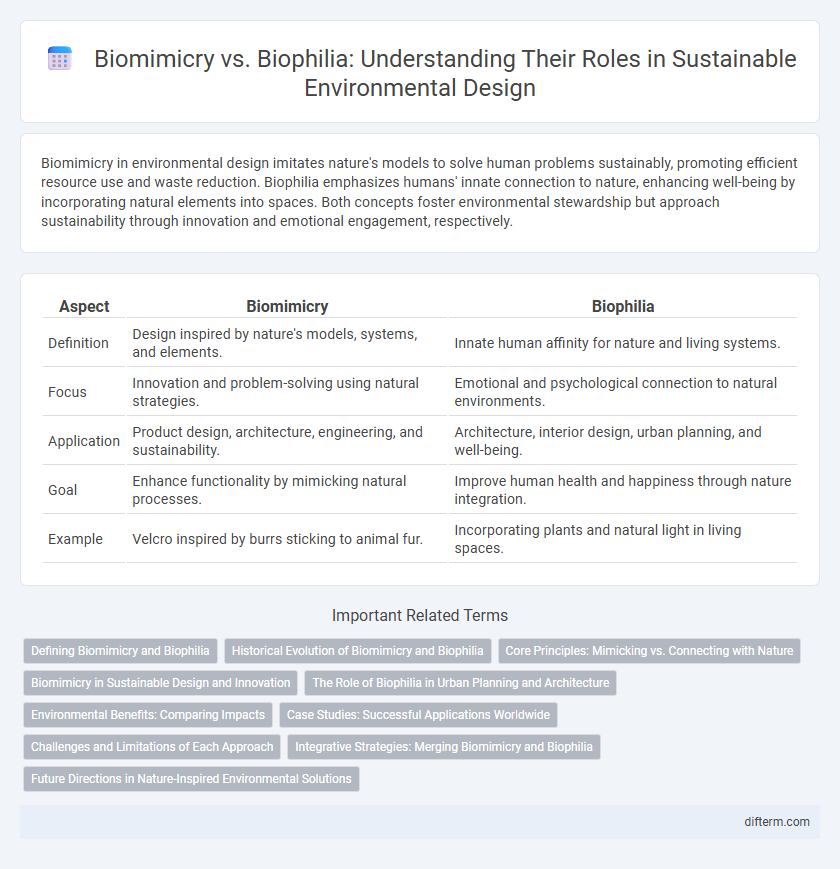Biomimicry in environmental design imitates nature's models to solve human problems sustainably, promoting efficient resource use and waste reduction. Biophilia emphasizes humans' innate connection to nature, enhancing well-being by incorporating natural elements into spaces. Both concepts foster environmental stewardship but approach sustainability through innovation and emotional engagement, respectively.
Table of Comparison
| Aspect | Biomimicry | Biophilia |
|---|---|---|
| Definition | Design inspired by nature's models, systems, and elements. | Innate human affinity for nature and living systems. |
| Focus | Innovation and problem-solving using natural strategies. | Emotional and psychological connection to natural environments. |
| Application | Product design, architecture, engineering, and sustainability. | Architecture, interior design, urban planning, and well-being. |
| Goal | Enhance functionality by mimicking natural processes. | Improve human health and happiness through nature integration. |
| Example | Velcro inspired by burrs sticking to animal fur. | Incorporating plants and natural light in living spaces. |
Defining Biomimicry and Biophilia
Biomimicry is an innovative design approach that emulates nature's models, systems, and elements to solve human challenges sustainably. Biophilia refers to the innate human affinity for nature, promoting well-being through direct interaction with natural environments and organic forms. Both concepts enhance environmental design but differ in focus: biomimicry targets functional inspiration, while biophilia emphasizes emotional and psychological connections to nature.
Historical Evolution of Biomimicry and Biophilia
Biomimicry traces its roots to ancient civilizations observing natural processes for innovation, evolving significantly in the 20th century with figures like Janine Benyus formalizing its principles in the 1990s. Biophilia, a concept popularized by biologist E.O. Wilson in the 1980s, emphasizes humans' inherent affinity for nature, influencing psychological and architectural studies. Both concepts highlight the integration of natural patterns and human well-being, shaping contemporary environmental design and sustainability movements.
Core Principles: Mimicking vs. Connecting with Nature
Biomimicry centers on replicating nature's designs and processes to innovate sustainable solutions, emphasizing emulation of biological strategies for human challenges. Biophilia emphasizes fostering a deep emotional and psychological connection between humans and the natural environment, promoting wellbeing through interaction and immersion. Core principles contrast by biomimicry focusing on mimicking nature's functionality, while biophilia prioritizes nurturing an intrinsic bond with natural ecosystems.
Biomimicry in Sustainable Design and Innovation
Biomimicry leverages nature's models, systems, and elements to inspire sustainable design and innovation, reducing environmental impact. This approach enables the creation of energy-efficient buildings, water-saving technologies, and biodegradable materials by emulating biological processes. Integrating biomimicry in architecture and product development promotes circular economy principles and enhances resilience against climate change.
The Role of Biophilia in Urban Planning and Architecture
Biophilia facilitates a deeper human-nature connection by integrating natural elements like green walls, daylight, and water features in urban planning and architecture, promoting well-being and sustainability. Urban designs inspired by biophilia prioritize biodiversity, air quality, and mental health, resulting in healthier, more resilient communities. Unlike biomimicry, which mimics nature's designs for innovation, biophilia centers on fostering emotional and physical relationships between people and natural environments to enhance urban living spaces.
Environmental Benefits: Comparing Impacts
Biomimicry drives environmental benefits by inspiring sustainable innovation through nature-inspired designs that reduce resource consumption and waste. Biophilia enhances well-being and ecological awareness by fostering direct human-nature connections, encouraging conservation and biodiversity. Both approaches contribute uniquely, with biomimicry optimizing industrial processes and biophilia promoting conservation-driven behavior in urban planning.
Case Studies: Successful Applications Worldwide
Case studies of biomimicry showcase innovative designs inspired by natural processes, such as the Eastgate Centre in Harare, Zimbabwe, which uses termite mound ventilation for efficient cooling. Biophilic design has been successfully implemented in projects like Amazon's Spheres in Seattle, promoting employee well-being through direct interaction with natural elements. Both approaches demonstrate impactful environmental and social benefits by integrating nature into architecture and urban planning globally.
Challenges and Limitations of Each Approach
Biomimicry faces challenges in replicating complex natural processes with current technology, often requiring significant resources and interdisciplinary expertise. Biophilia encounters limitations in quantifying its psychological benefits and integrating natural elements into urban environments without compromising functionality. Both approaches struggle with scalability and cost-effectiveness when applied in large-scale environmental design projects.
Integrative Strategies: Merging Biomimicry and Biophilia
Integrative strategies combining biomimicry and biophilia enhance sustainable environmental design by emulating natural processes while fostering human-nature connections. Biomimicry contributes innovative solutions through mechanisms like photosynthesis-inspired solar panels, whereas biophilia emphasizes psychological well-being by incorporating natural elements into built environments. Merging these approaches promotes resilient ecosystems, improves air quality, and supports biodiversity within urban settings.
Future Directions in Nature-Inspired Environmental Solutions
Future directions in nature-inspired environmental solutions emphasize integrating biomimicry and biophilia to enhance sustainability and human well-being. Biomimicry drives innovation by mimicking natural processes for energy efficiency and waste reduction, while biophilia fosters urban designs that reconnect people with nature, improving mental health and biodiversity. Combining these approaches can lead to resilient ecosystems, sustainable materials, and regenerative communities that address climate change and resource scarcity.
biomimicry vs biophilia Infographic

 difterm.com
difterm.com